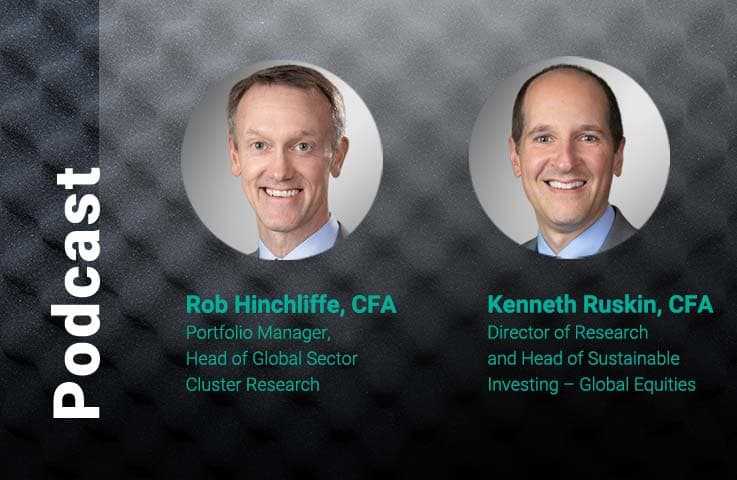2025 Midyear Equity Outlook: Riding the Waves of Volatility

Rob Hinchliffe, CFA
Portfolio Manager, Head of Global Sector Cluster Research

Kenneth Ruskin, CFA
Director of Research and Head of Sustainable Investing – Global Equities

Christopher Pettine, CFA
Healthcare Analyst - Global Equities

Michael Mark
Client Portfolio Manager, Equities
While the first half of 2025 has been unsettling for equity investors, throughout this turbulent period we have continued to seek mispricings indicating that a company’s prospects may be underappreciated by the market.
Several strong trends are still supporting industrials, including the resolution of post-Covid de-stocking and rising adoption of artificial intelligence (AI) in industrial settings, which should drive demand for industrial companies that supply the infrastructure to support AI’s expansion.
Pharmaceuticals may face the most challenging outlook, with the sum fear of tariffs, most-favored nation (MFN) pricing, and Medicare drug negotiations under the Inflation Reduction Act weighing on sentiment. While dark clouds have gathered over the healthcare sector, we still see opportunities in pharma (advances in obesity treatments and immunology), biotech (in rare and autoimmune disease treatments), and medical devices.

The first half of 2025 has been a wild and unsettling ride for equity investors. Markets grew increasingly volatile leading up to President Trump’s 2 April tariff announcements and then plummeted as the stark reality of “Liberation Day” sank in for investors, who were shocked by the tariffs’ severity. With “TACO trade” dynamics having since settled in amid Trump’s start-and-stop tariff moves – and the courts still deciding whether the tariffs are even legal – markets have largely made up their losses, but with volatility promising to persist.
Throughout this rocky period, we have continued to seek to identify mispricings indicating that a company’s prospects may be underappreciated by the market amid the turbulence.
Looking to the second half of 2025, while all sectors are affected to varying degrees by the rapid-fire shifts in trade policy, we are focused on two that may feel the greatest impact: industrials and pharmaceuticals.
Industrials: After a long pause, are spending plans taking shape?
Among industrial companies and their clients, spending plans might soon start to crystallize again after months of indecision. Since the middle of 2024, uncertainty about the US presidential election, followed by question marks around trade policy, had caused many to put plans on hold. Much of that uncertainty persists, as tariff policy remains unresolved, complicating spending decisions for the second half of the year. Yet based on both our own conversations with companies and recent surveys,1 companies are planning on spending over a two-year horizon and are optimistic that the capex freeze could thaw in the next couple of months.
This is not to say, however, that the uncertainty that had caused changes in corporate decision-making – and, critically, in the way companies communicate (or don’t communicate) with investors, and thus individual stock-level volatility – is behind us. Automakers, for instance, are now grappling with the implications of Trump’s latest steel and aluminum tariff hikes, which could increase production costs precipitously and raise prices for consumers down the line.
As active investors focused on the long-term lifecycles of companies, we’re attuned to the underlying trends that may be supporting or hindering sectors; we tend to look past (and take advantage of) near-term blips. Several strong, positive trends are still supporting industrials, including the resolution of post-Covid de-stocking; this has contributed to a 2.5-year industrial recession, which should help spring-load a recovery when uncertainty resolves.
Another is the rising adoption of artificial intelligence (AI) in industrial settings, especially as costs come down. AI is getting smarter faster, and we are bullish on AI’s long-term potential in industrial settings and expect it to drive demand for industrial companies that supply the infrastructure to support AI’s expansion.
AI’s productivity-boosting benefits will also amplify two additional tailwinds: the rise in automation and increased near-shoring. Near-shoring requires automation, which requires spending on automation, which AI helps catalyze. These longer-term benefits feed into one another and will become more evident as the disruptions from tariff uncertainty resolve.
Most industrial companies are still reporting that they can pass along whatever tariffs are imposed while maintaining their profits, which could set the stage for an industrial rebound.
Healthcare: Dark clouds are still gathering, but more clarity is on the horizon
Pharmaceuticals may face the most challenging outlook among sectors. The Trump administration has made pharmaceuticals a key target for sector-specific tariffs, a headwind to sales and earnings that the market is attempting to price in. While we see a tariff range of 15% to 25% as credible, clarity on many levels is lacking, and a wide range of outcomes are possible. While the Section 232 investigation – initiated to determine the effects on national security of imports of pharmaceuticals and pharmaceutical ingredients – is viewed by many as leverage for negotiation to bring manufacturing back to the US and to lower drug prices, we should still expect a baseline tariff at some level.
Also under consideration is a proposed most-favored nation (MFN) pricing model for prescription drugs, which would align US drug prices with those in comparably developed nations. The US Department of Health and Human Services (HHS) announced in May that it would take immediate steps to implement President Trump’s executive order to this effect. The MFN pricing would apply primarily to brand-name drugs without generic options, and drug manufacturers would be tasked with aligning their prices to the HHS price targets. There is debate over the legality of the proposed MFN, and whether it can be implemented without congressional legislation.
The sum fear of tariffs, MFN pricing, and the implementation of negotiation for Medicare drugs under the Inflation Reduction Act has weighed on sentiment and caused compression in price/earnings multiples for the pharma sector.
While dark clouds have gathered over the healthcare sector, there is hope that policy clarity will emerge in the coming weeks and months. As investors eventually re-engage in the sector, there are several companies that are innovating to stay ahead of the competition and produce better health outcomes. We are finding those opportunities in pharma (with advances in obesity treatments and immunology), biotech (in rare and autoimmune disease treatments), and medical devices. We remain underweight healthcare providers amid cutbacks in government funded programs, notably Medicaid, which had been expanded during the pandemic.
Riding out the turbulence comes down to quality companies and a resilient consumer
When volatility and uncertainty are the norm, it’s especially crucial for asset managers to maintain close communication with their investee companies while looking critically at the guidance companies are communicating publicly. Corporate management teams have taken varied approaches in communicating their outlooks. Some have included the expected impact of tariffs into their guidance, while others have excluded these impacts. Some companies have retracted their full-year guidance altogether. In this environment, it is crucial not to confuse simple conservatism with true discipline – the latter of which we associate with quality.
S&P 500 Companies Have Given Mixed Guidance by Sector
Percentage of companies with positive vs. negative FY 2025/2026 guidance

Source: FactSet as of 13 June 2025.
The strength of the consumer could be a big determinant of outcomes. So far, consumers have remained fairly resilient, but the biggest price impacts from the tariffs have yet to come – that is, if the 90-day pause ends in July as planned, and if the courts are not successful in challenging the tariffs’ legality. Both are big “ifs,” but if the tariffs do unfold in the second half, the potential for demand destruction and consumers’ ability to bear the cost burden will be key questions.
Companies that have the pricing power, scale, and flexibility to navigate changes in the operating landscape are the ones that will tend to perform well over time. Whatever happens, we remain focused on seeking out companies with the ability to innovate and respond quickly to geopolitical and policy developments amid the turbulence that surely lies ahead.
For more insights into the trends moving markets in the second half of the year, see our 2025 Midyear Investment Outlook.
1 Citi Research, "Global Industrials: Automation Survey Suggests an Inclination Toward Automation Spending Despite an Uncertain Environment," 4 June 2025.
Disclosure
Investing involves risk, including possible loss of principal. The information presented herein is for illustrative purposes only and should not be considered reflective of any particular security, strategy, or investment product. It represents a general assessment of the markets at a specific time and is not a guarantee of future performance results or market movement. This material does not constitute investment, financial, legal, tax, or other advice; investment research or a product of any research department; an offer to sell, or the solicitation of an offer to purchase any security or interest in a fund; or a recommendation for any investment product or strategy. PineBridge Investments is not soliciting or recommending any action based on information in this document. Any opinions, projections, or forward-looking statements expressed herein are solely those of the author, may differ from the views or opinions expressed by other areas of PineBridge Investments, and are only for general informational purposes as of the date indicated. Views may be based on third-party data that has not been independently verified. PineBridge Investments does not approve of or endorse any republication of this material. You are solely responsible for deciding whether any investment product or strategy is appropriate for you based upon your investment goals, financial situation and tolerance for risk.



